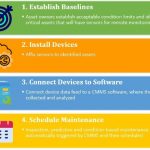
It’s another Saturday at my house. In this video we use RCM principles to determine if the replacement task my husband is performing on his 1989 Toyota Supra is both technically appropriate and worth doing. [Read more…]
Your Reliability Engineering Professional Development Site
A listing in reverse chronological order of these article series:
by Nancy Regan Leave a Comment

It’s another Saturday at my house. In this video we use RCM principles to determine if the replacement task my husband is performing on his 1989 Toyota Supra is both technically appropriate and worth doing. [Read more…]
by Robert (Bob) J. Latino Leave a Comment

Guest post by Charles J. Latino
At the root of most mechanical and system failures lurks a human cause. Insights into what to look for when solving human-caused failures are essential. Human error is generally described as behavior that goes beyond the norm. A proper definition in the context of this article is, “an action planned but not carried out according to the plan”. To find a means of minimizing human error, one must first understand its characteristics: [Read more…]
by James Reyes-Picknell 2 Comments

The last article speaks to who should run your storeroom – NOT maintenance. It also leaves us hanging a bit – what should go into the store room to ensure good supply of needed materials, when needed? [Read more…]
by Nancy Regan Leave a Comment

My mentor John Moubray taught me that managing the consequences of failure is the essence of RCM. Watch how I used RCM principles to change the consequences of failure with a Default Strategy. [Read more…]
by Gina Tabasso Leave a Comment

by Alan Ross
As VP of reliability at my company, I often meet customers when they are at the tyranny of the urgent. They’ll have a significant problem, multiple questions, and a big decision to make.
Just recently I was with one of our customers as he was facing one of those big decisions. It was a tough one. [Read more…]
by Robert (Bob) J. Latino Leave a Comment

In order to know if all RCA is the same, we first have to define ‘What is RCA?’ On the surface this seems quite simple, but unfortunately it is quite complex. When I train or present speeches around the world, I often poll my audiences about how they define ‘RCA’. The fact is I will get as many answers, as I have people that I ask. This is unfortunate because there is no universally accepted definition of what ‘RCA’ actually is. Are there definitions out there, absolutely! There are hundreds of them. Various regulatory agencies have their own such definitions, as do corporations and companies. However, when definitions differ between agencies, corporations and industries, it is hard to measure the effectiveness of ‘RCA’ across the board, because everyone considers whatever they are doing, as ‘RCA’.
by James Reyes-Picknell Leave a Comment

Perhaps the number one excuse that maintainers use for being unable to get repairs executed in a timely manner is to blame parts and their supply. For the maintenance technician on the tools, it’s a very obvious problem. No parts or materials means that work simply cannot be done without some sort of work-around / jury-rigged solution. The alternative is to get the needed materials as quickly as possible – often incurring substantial premiums on the price of the materials and premium shipping charges. When the parts arrive, usually after some waiting period, all emphasis is on getting the job completed even if it requires overtime effort and costs. This makes compliance to budget a real challenge and invites plenty of queries from accounting, finance and general management about our ability to work within a budget. As fire fighters we are sometimes heroes, but as managers we are failures. [Read more…]
by Robert (Bob) J. Latino Leave a Comment

No matter where we work, we will experience failures or ‘undesirable outcomes’ of some kind. As long as we work with other humans, this will indeed be the case. These failures may surface in the form of production delays, injuries, customer complaints, missed deadlines, lost profits, legal claims and the like.
In order to prevent recurrence of any such undesirable outcome, we have to truly understand the causes that led up to that bad outcome. In many of our worlds, the process used to analyze and understand what went wrong is called Root Cause Analysis or RCA. However, for the sake of this article, call this process whatever you want; problem solving, brainstorming, troubleshooting, etc. The common denominator of these terms, is they desire to resolve a failure and ensure it does not happen again.
Let’s get away from labels and specific industries and focus on the anatomy of a ‘failure’. Where does a failure come from? Think about this no matter where you work and see if it applies. [Read more…]
by James Reyes-Picknell Leave a Comment

Many believe that if you can’t measure it, you can’t manage it. That’s just not right. Measurements can only count what is countable – dollars, production numbers, headcounts, timeliness, etc. They can’t count the achievement of objectives unless those objectives are purely numeric in nature. [Read more…]
by Gina Tabasso Leave a Comment

by Alan Ross
A few weeks ago I went to a customer site where they had a meeting of the minds for their reliability team. The host was a multi-site paper manufacturer with an intelligent approach to plant reliability. The reliability team included, of course, several reliability professionals, but there were procurement people there too. That’s not unusual. We’re finding more and more that procurement and reliability often work hand in hand. [Read more…]
by James Reyes-Picknell Leave a Comment

In theory, integrated computer systems enable multiple uses for any single piece of data that is input only once. Data becomes available wherever it needs to be in whatever business process is integrated into the whole. In a sense it is like our brains – information and experience is registered once and available for access whenever needed for any purpose. Integrated systems should make our lives at work easier, but they seldom do that. Integrated business computer systems are very complex and can be very difficult to use. Imagine that they must support many separate business processes and departments, all of whom have different “languages” and ways of doing things. [Read more…]
by Bryan Christiansen Leave a Comment

The biggest change in asset management practices and maintenance models in the coming years will be the shift from corrective and preventive to predictive and condition-based maintenance that is built on real-time as well as historical data.
With emerging new technologies like IoT (Internet of Things) and easy access to the Internet and cloud storage capabilities, accessibility to information and remote monitoring of assets can be done anytime and from any location and device. This calls for a reliable remote monitoring setup accompanied by a robust and proven management system to track and manage all that data. And it is this combination precisely that can elevate your business to a world-class maintenance program.
by James Reyes-Picknell Leave a Comment

You’ve acquired and are now implementing a new CMMS / EAM (Computerized Maintenance Management System / Enterprise Asset Management) computer software program to help you manage maintenance. It may be a simple functional system that only looks after maintenance and likely Maintenance, Repair and Operating (MRO) spares, or it may be part of a much bigger enterprise system that handles many business functions. Regardless, one question almost always arises when converting from one to another system – what should we do about our old data? [Read more…]
by Gina Tabasso Leave a Comment

by Alan Ross
“Why don’t they care?”
“About what?”
“About electrical system reliability?”
“Who says they don’t care?”
“You do. Quite often, as a matter of fact.” [Read more…]
by James Kovacevic Leave a Comment

I am often asked, what is the benchmark for a particular KPI. At first, I would quickly answer the target from the SMRP Best Practices Guide. Depending on the organization and the maturity, I would either see their faces light up or see them shut down. If they shut down, what momentum was present, quickly vanished. If they were meeting the target (and the KPI and supporting data checked out), the momentum would fade a bit, as they were hitting the target.